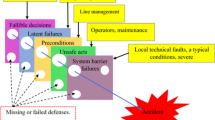Abstract
This paper reports on human factors data traceability and analysis of the European Community’s Major Accident Reporting System (MARS). This is the main EU instrument to major accident data collection, analysis and dissemination for process industry according to the provisions of the Seveso II Directive. To date, the MARS database counts approximately 700 Seveso-type major events (November 2008). The MARS system is investigated in terms of human factors data and case studies exploring the relevance of human factors in accident events causation and identification issues. The human factors model and taxonomy as it is applied in the MARS system is reviewed. Criteria to enhance traceability and analysis about human related causes are then considered in detail. Finally, certain limitations affecting the system are pointed out. Findings are expected to favour future modelling and research efforts toward further MARS system improvements.









Similar content being viewed by others
References
Baranzini D (2007) Human factors data traceability and analysis in MARS. OECD-CCA Workshop on Human Factors in Chemical Accidents and Incidents 8–9 May 2007, Potsdam, Germany
Baranzini D, Cacciabue PC (2006) Modelling co-ordination effects in complex work systems: the aviation maintenance case. In: de Waard D, Brookhuis KA, Toffetti A (eds) Developments in human factors in transportation, design, and evaluation. Shaker Publishing, Maastricht, pp 225–237
Cacciabue CP (2004) Guide to applying human factors methods: human error and accident management in safety critical systems. Springer, London
Christou MD (1999) Analysis and control of major accidents from the intermediate temporary storage of dangerous substances in marshalling yards and port areas. J Loss Prev Process Ind 12(1):109–119
Council Directive (1997) Council Directive 96/82/EC of 9 December 1996 on the control of major accident hazards involving dangerous substances. Official Journal of the European Communities 1997 L 10, 14.1.97
Drogaris G (1993) Major accident reporting system—lessons learnt from accidents notified, CEC-JRC Ispra, ISBN-0-444-81665-8. Elsevier, Amsterdam
Hawkins FH (1987) Human factors in flight. Gower Technical Press, Aldershot
Hollnagel E (2004) Barrier analysis and accident prevention. Ashgate, Aldershot
HSE (2005) Inspectors toolkit: human factors in the management of major accident hazards. http://213.212.77.20/humanfactors/comah/toolkitintro.pdf [19.12.2006]
ICAO (1997) Accident/incident reporting manual-ADREP 2000 draft (1997). ICAO, Montreal, Canada
Mushtaq F, Christou MD, Duffield JS (2003) The European Community’s major accident reporting system (MARS): lessons learnt relating to risk management. In: IBC’s fifth Annual Conference on Safety Case Experience, April–May 2003, London
Nivolianitou Z, Konstandinidou M, Christou MD (2006) Statistical analysis of major accidents in petrochemical industry notified to the major accident reporting system (MARS). J Hazard Mater 137(1):1–7
Rasmussen J (1986) Information processes and human–machine interaction. An approach to cognitive engineering. North–Holland, Oxford
Rasmussen J (1997) Risk management in a dynamic society: a modelling problem. Saf Sci 27:183–213
Rasmussen J, Pedersen OM, Mancini G, Carnino A, Griffon M, Gangolet P (1981) Classification system for reporting event involving human malfunctions. RISØ-M-2240, EUR-7444 EN, CEC-JRC, Luxembourg
Reason J (1990) Human error. Cambridge University Press, New York
Sales J, Mushtaq F, Christou M (2007a) Analysis of Major Accidents reported to the MARS database during the period 1994–2004 EUR 22800 EN-Joint Research Centre, Institute for the Protection and Security of the Citizen
Sales J, Mushtaq F, Christou MD, Nomen R (2007b) Study of major accidents involving chemical reactive substances: analysis and lessons learned. Trans I Cheme Part B Process Saf Environ Prot 85(B3):117–1248
Author information
Authors and Affiliations
Corresponding author
Rights and permissions
About this article
Cite this article
Baranzini, D., Christou, M.D. Human factors data traceability and analysis in the European Community’s Major Accident Reporting System. Cogn Tech Work 12, 1–12 (2010). https://doi.org/10.1007/s10111-009-0129-4
Received:
Accepted:
Published:
Issue Date:
DOI: https://doi.org/10.1007/s10111-009-0129-4




